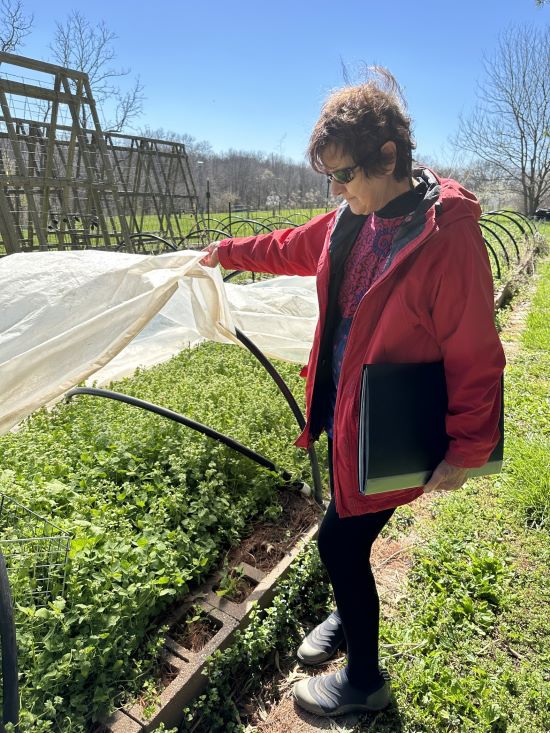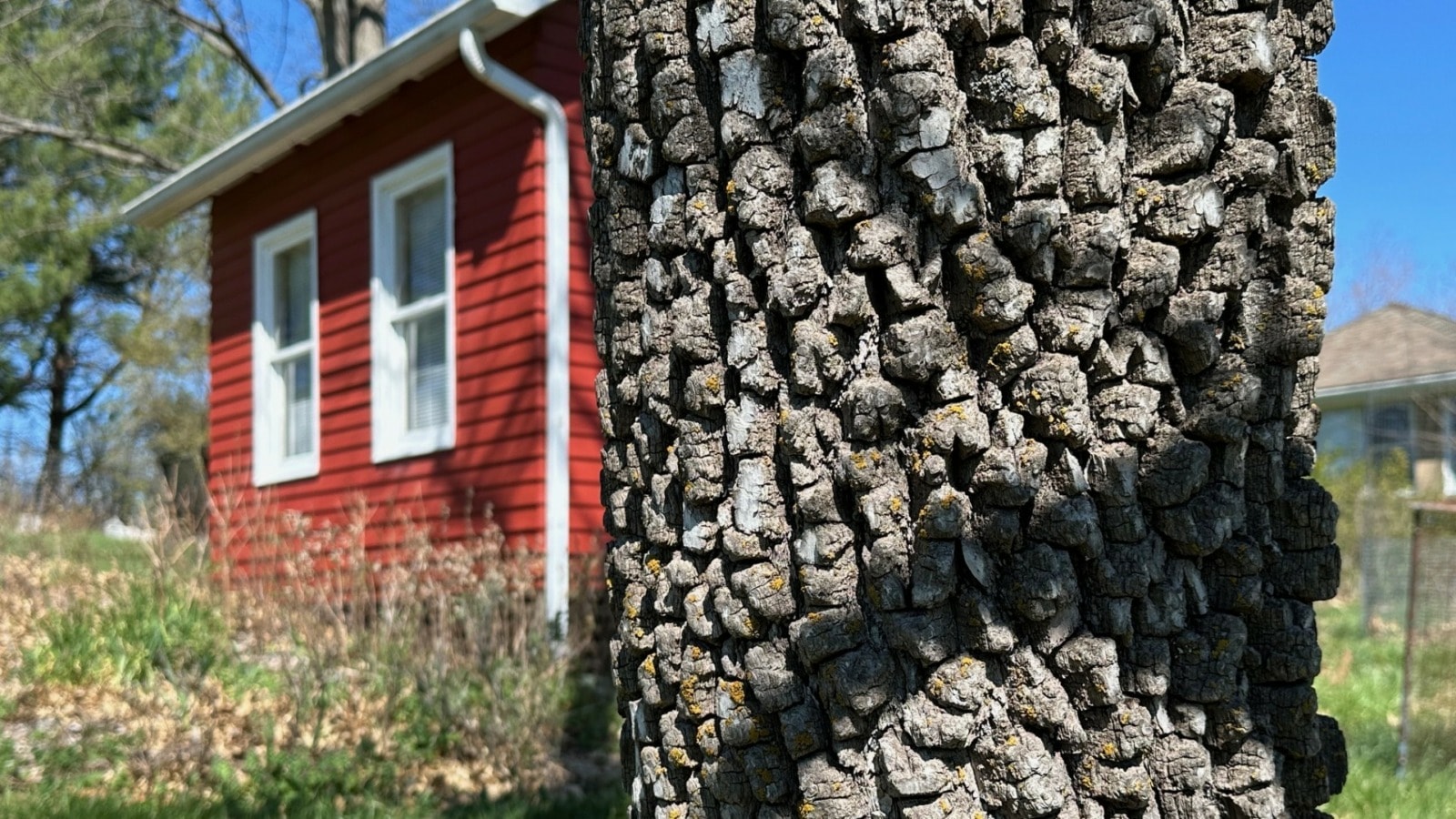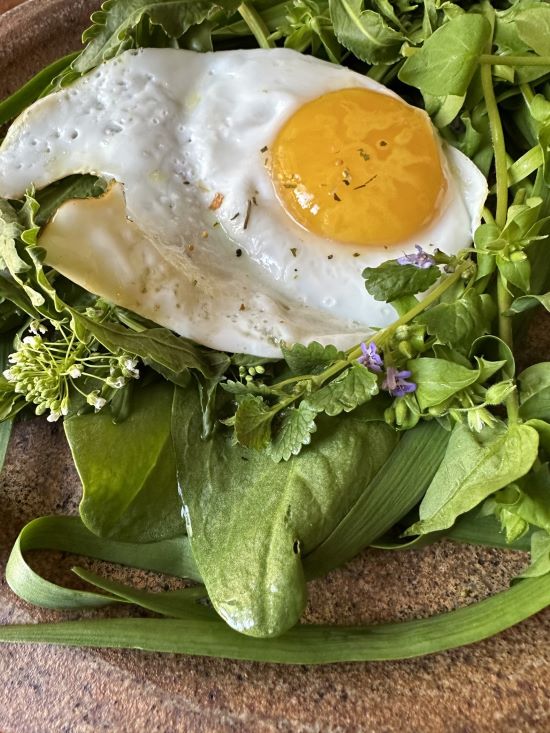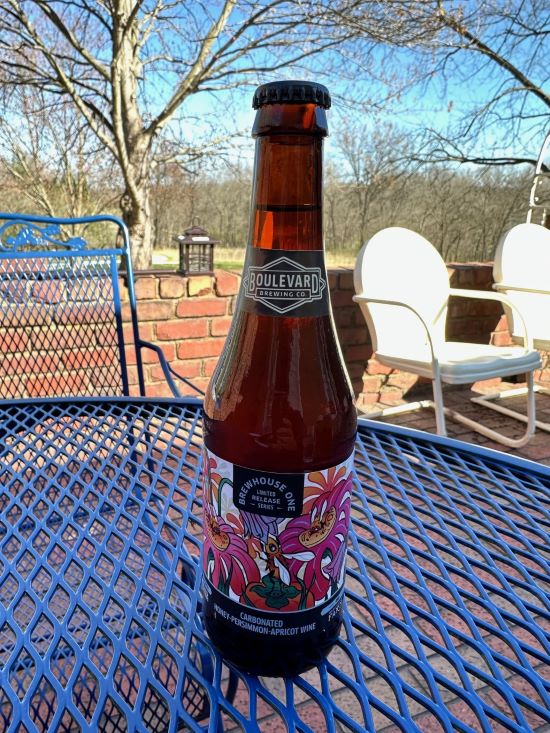Linda Hezel Harvests the Many Fruits of Her Labor Advocate for Biodiversity and Regenerative Farming Practices
Published April 19th, 2024 at 6:00 AM
Above image credit: Prairie Birthday Farm in Kearney, Missouri, offers brewers, chefs and eaters a variety of nutrient-dense fruits, greens and herbs featuring native plants and grown using regenerative farming practices. (Jill Wendholt Silva | Flatland)Linda Hezel recalls the first cold call she ever made to a chef in the early 2000s.
“I took wild persimmons and said: ‘Taste this. Would you buy it?’”
Last fall, Hezel hand harvested 90 pounds of wild persimmons for Boulevard Brewing Co., which combined the fruit with local honey to create a limited-edition carbonated persimmon-apricot wine released this spring.
As steward of the 15-acre Prairie Birthday Farm located on the outskirts of Kearney, Missouri, Hezel has spent the last three decades growing nutrient dense food while promoting biodiversity and ecologically based regenerative farming practices.

A spring tour of the farm is accompanied by bird song and showcases a natural landscape where 56% of the trees and shrubs are food bearing and 84% are native to North America.
When conducting tours, Hezel carries a black artist’s portfolio under her arm holding photos, menus, statistics and quotes from her favorite environmentalists. She flips to a photo of the property she bought with her husband in 1993, a time when the ‘70s-style ranch house set on a plot of lawn looked desolate and forlorn by comparison.
Hezel grew up on a farm outside of St. Louis. She earned a doctorate in nursing, but eventually returned to her roots. Influenced by Rachel Carson’s groundbreaking book “Silent Spring,” she initially planned to grow organic, pesticide-free food for her sons. But eventually, her unique bounty of fresh fruit, vegetables and herbs offered an opportunity to collaborate with local brewers and chefs, who like herself, were eager to delve into the flavors of the local terroir.
A year after moving to The Campground in the West Bottoms, James Beard Emerging Chef: Midwest semifinalist Jeffrey Workman eagerly waits for the arrival of Hezel’s specialty ingredients indigenous to the area.
“Truly, Linda is one of a kind,” Workman says. “She offers a very unique perspective on the culinary scene here in Kansas City, and I don’t know if a lot of people recognize how important she is. I think the current direction of the food scene is inspired by her more than we probably realize.”
Row No More
Each tree, shrub or grass at Prairie Birthday Farm tells a story of stewardship of the land and the artisanal fruits of Hezel’s labor.
Persimmon trees typically grow wild throughout the Midwest. The trunks have a hard, thick gray bark with deep grooves that look as leathery as elephant skin. When harvested, the wood is hard enough to be fashioned into pool cues or golf clubs.

An orchard is part of a planting two years after the family took over the property. The English heirloom Bramley apple tree dating back to the 1850s is dotted with deep pink buds blossoming into paler pink flowers.
Instead of grafting branches onto existing rootstock, Hezel is experimenting with air layering, a technique that propagates new trees and shrubs from stems that are still attached to the parent plant.
Nearby, a swath of restored prairie under careful management, including frequent burning by the local fire department as part of its training exercises, thrives. The family used to manage the burn, but there is now too much combustible plant material to ensure control.
A native spicebush that has popped up between the chicken coop and barn has peaked Hezel’s insatiable appetite for knowledge about the slightly manicured landscape. The leaves, stems, blossoms and berries of the intensely aromatic bush are edible. The leaf has a mild chai flavor. Beyond the kitchen, the native plant is being studied for its possible anti-inflammatory and anti-cancer properties.
“My philosophy is that whatever is here, if it needs intensive care, it’s the wrong plant for the place,” Hezel says. “Attempting to control Mother Nature — clearly unsuccessfully — is silly, because we don’t understand what plants can do because we’re so busy trying to duke them into submission that we miss the point about their resilience and benefits.”
Curated Greens
Most chefs get their introduction to Prairie Birthday Farm through its mixed salad greens. The antithesis of nutrient-robbing row crops planted across the Midwest as a patchwork quilt of corn, wheat and soybeans, Hezel raises the plastic sheeting still in place in case of a late frost to reveal what many consider undesirable weeds: dandelion, lamb’s quarter, lovage, sweet melissa and chickweed.
Last summer, diners attending chef Rick Mullins’ pop-up dinner series held at the farm began their evening with a tour. They then sat down to a bundle of Just Harvested Greens tied with a chive and misted with sumac and spruce intended to be eaten out of hand.

The multi-course Redbud pop-up dinner showcased native wild edibles using a variety of preservation techniques. It ended with a dessert featuring fluff of meringue and Mullins’ favorite ingredient: heirloom roses.
“I always think of Linda as the catalyst for me to start digging deeper on native plants,” says Mullins. “I see her as a champion for food systems and nature.”
Although flowers are traditionally employed as a garnish, Mullins uses rose petals to infuse vinegars or flavor fermented honeys. He’s currently experimenting with variations on cooked sunchokes with a rose-honey-vinegar glaze.
Each week, Hezel sends out a list of available products that includes electronic links to information not readily accessible in cookbooks. She also builds in time in her delivery schedule to talk about the ingredients with chefs.
“When I work with an ingredient, I need to know every single thing, and she’s always had that info for me,” Mullins says. “Her willingness to teach and educate is disarming to me.”
Legacy Building
Now 70-something, Hezel could offload the delivery responsibilities to someone else, but she would miss the connection she is able to foster with chefs.
“What’s nice is that she takes the time to talk with us and share what other people have done with an ingredient,” says Workman, executive chef at The Campground, a cocktail bar and restaurant in the West Bottoms known for its “foraging vibe.”
Although not listed by name on the menu, Workman’s most successful dish so far featuring Prairie Birthday Farm is coal-roasted carrots served with a wild herb salsa verde that offers subtle changes in flavor throughout the season.
But Workman is also open to the reality that not every culinary ingredient in nature’s pantry results in an immediate bullseye when it arrives in the kitchen.
Take his clever “dirt cup” dessert featuring milkweed pods to infuse a pudding nestled in a chocolate cookie crumb crust and topped with butterfly gummies.

“It sounded super fun, and it was a good story to tell and all that, but there was some reaction with the flower and dairy that curdled it every time,” he says.
While Workman goes back to the drawing board, Hezel watches the development surrounding her farm with a wary eye.
“It’s all just toxic lawn. It’s criminal,” says Hezel, who has snatched native plants from the jaws of a bulldozer more than once to save them from being scraped off.
Owing to the lack of volume, the boutique specialty items Hezel produces for a narrow customer base go for higher prices. Her business model depends on customers who are willing to pay a premium to care for the earth while extracting flavor.
“I don’t want to charge the lowest price, and I think scaling up is a scam. It’s to grow more so you can charge less. How does that work? Even on paper that sounds like a bad idea,” Hezel says. “I don’t want to grow 1,000 pounds of tomatoes and compete with everyone when they are ripe. That’s boring and a bad business design.”
With only 2% of the population growing all the food in the United States, Hezel encourages everyone to learn how to forage in their own space.
“I think we should be teaching eaters how to eat the plants, and I think, with climate change, people are going to wig out because they’re not ready for eating what’s in their space seasonally,” she says. “They can’t identify anything, and they don’t know how to grow anything.”
Meanwhile, Hezel calls herself a “perpetual, humble learner” as she contemplates her legacy. She wishes she was 30 years younger and shakes her head at the uphill battle the next generation of farm stewards will have as they adapt to the changing climate.
“Just letting her land curate what is available and not forcing anything to grow, and offering so much of what people would cut away as weeds, she reflects all our area has to offer,” Workman says.
Jill Silva is a James Beard award-winning food editor and writer.


